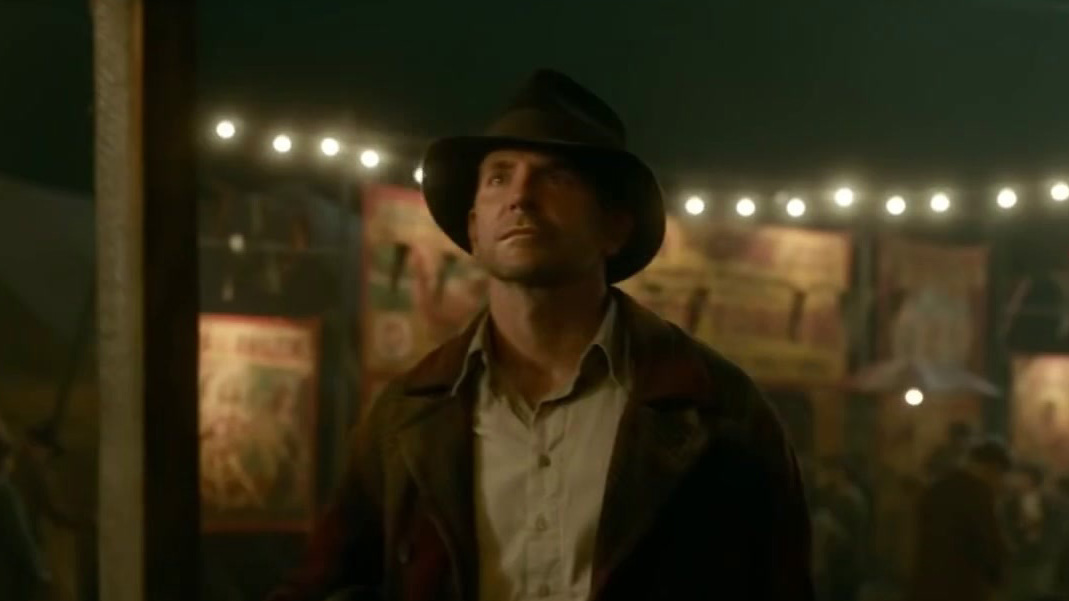Nightmare Alley

Despite its darkness and pessimism, Guillermo del Toro’s adaptation of William Lindsay Gresham’s novel Nightmare Alley is a shapely piece of entertainment that may cheer you up. Grim as it often is, it’s been put together with such obvious love and devotion that its energy carries us through Gresham’s moralistic tale of a con artist — Bradley Cooper’s Stanton Carlisle — whose imposture may or may not withstand the reality that there will always be someone shrewder, more ruthless and more powerful than he is. Gresham’s book is a sandwich of crisp bread slices surrounding a bit of soggy meat, though del Toro and co-writer Kim Morgan streamline the narrative. They keep the bread fresh, and they retain Gresham’s bleak ending while importing a stellar final line from the 1947 film version.
Stanton arrives at a carnival in 1939 and learns the ropes. He learns how to do “cold readings” as a self-proclaimed psychic; he also learns how an unscrupulous carny barker (Willem Dafoe in a brief but vivid turn) creates a “geek” — an attraction based on a down-and-out drunk’s desperate willingness to do disgusting things in exchange for booze. Stanton falls in love with Molly (Rooney Mara), who does tricks with electricity, and they leave the carnival to strike out on their own scams. It’s a bit of a bummer when Cooper leaves the seamy, intriguing milieu of strongmen and freaks in the company of Rooney Mara, who unfortunately remains a null presence. But the movie is still beautiful, with golden cinematography (Dan Laustsen) and richly crafted production design (Tamara Deverell) that keep our eyes happily engaged. Nightmare Alley is dark but not dreary.
Stanton and Molly do their psychic act for rich suckers. A canny psychiatrist, Dr. Lilith Ritter (Cate Blanchett), pegs Stanton as a flim-flam man the minute she lays eyes on him, but is drawn to his confidence and technique. Along about the hour-and-a-half mark, Richard Jenkins enters the picture as the richest sucker of all, who is led to believe Stanton can put him in spiritual contact with a past lover. Jenkins, as he did in The Shape of Water, grounds a del Toro film in bitter humanity, though he’s playing much more of a scoundrel this time. Ultimately, nobody in this story is an innocent. The higher up you go, the more corrupt people you find. The picture of a pre-WWII America gouged by financial ruin and despair is deftly painted. Bradley Cooper, who spends a lot of his screen time with Rooney Mara and is thus casting his charisma into a vacuum, comes alive when he can play with Jenkins, or, for that matter, with Toni Collette or David Strathairn or Ron Perlman.
Gresham’s novel is a bit mechanistic in the tradition of noir, but it’s almost painfully internal; we seem to pause and hear the thoughts and feel the feelings of everyone, in Gresham’s plain prose spiked with carny slang. Gresham stops for so long to detail the backstory of Molly and her beloved carny father that he seems carried away, almost surprised at how Molly is coming alive and developing flesh. Molly is pretty opaque in the movie; del Toro and Morgan really only have time to concentrate on Stanton, even with a 150-minute length. Del Toro seems a little deflated when he has to leave the carnival (Dafoe’s lair of mutated fetuses and animals in jars is like a room in del Toro’s famous collectible-filled home) and go to swanky wartime Chicago, so he reaches out gratefully for Cate Blanchett, who banks another suave Old Hollywood performance. Lilith, true to her name, is like a fancy vampire drawn to a different kind of parasite.
In recent years I’ve remained fond of the idea of Guillermo del Toro while being disappointed in his last few efforts. But Nightmare Alley, the sort of gift a director can only give to himself on the heels of an Oscar triumph, is the real thing, physically imposing (it’s always raining or snowing outside the windows; objects have an almost pensive solidity and heft) and psychologically sound. Laid bare, the story casts the carny world as capitalism in microcosm, with misfits straining hard to make those quarters and dimes. The gawkers for the carny acts, even the geek act, are not portrayed as ghoulish or shameful — del Toro is too good-natured for that, especially since we and he are in the same crowd. The people getting bilked are in pain they’ll pay good money to stop. Stanton is quite willing to take their pain and their money off their hands, either as a slick psychic or as a cautionary figure.
Explore posts in the same categories: adaptation, drama, film noir, one of the year's best, remake
Leave a comment